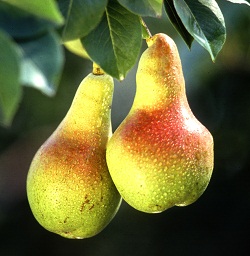Selecting Fruit Trees For Your Garden

There are many factors to consider when selecting a fruit tree for your garden. One of the most critical is chill hours. Chill hours are the number of hours at 45°F (7°C) or less that the fruit tree requires each winter in order break dormancy and flower and bear fruit the next season. A second factor is how much fruit you can eat, process or give away. A mature apple tree, for example, can provide 100 lbs of apples at harvest time. Finally, you need to consider how much space, ideally in full sun, can you provide a tree with that could grow to 15 feet tall and 10 feet wide.
- Chill hours, the hours below 45°F (7°C), are the number of hours that the fruit tree requires to bear fruit the following season. Chilling requirements vary tremendously between different fruits, as well as varieties within a species. To find your location's chill hours, go to the Weather Models page on the Fruit and Nut Research Information Center site.
- 100 pounds of fruit! That’s a lot of fruit! While you have many options in terms of what to do once your fruit is harvested including eating fresh, cold storage, freezing, canning, drying, donating to a food bank or sharing with neighbors, each does take time and in some cases equipment and expertise. Apples can be put in cold storage, while plums don’t do as well.
- How big do you want your tree? A standard apple can reach 30 feet tall. A semi-dwarf, only 15 feet. And a dwarf about 6 to 10 feet. Trees can be pruned to be smaller, but keeping a standard tree only 10 feet tall is going to require a lot more pruning and will stress the tree more than keeping a semi-dwarf that size.
- Different fruit trees have tendencies towards different diseases. In the San Francisco Bay Area, Santa Rosa plums are usually disease free. But peach trees often suffer from peach-leaf curl, which is an unattractive disease that curls the leaves. How much intervention in terms of spraying – even with low toxicity sprays - are you willing to do? Some fruit trees can be excellent in the landscape. Persimmon has beautiful orange leaves each fall color. Double Delight nectarine has beautiful dark pink double blossoms.
- One final consideration is pollination. Some trees require a different variety of the same species to pollinate the fruit. This would mean you might need to have two apple trees to get fruit. While other apple varieties are “self-fruitful” and don’t require a pollinator. If you have neighbors with fruit trees, finding out what varieties they have might help you select trees for your garden.
December through March is the ideal time to plant a fruit tree. During this time of year many nurseries have bare root fruit trees which are both economical and an ideal way to start your fruit orchard.
Further reading on fruit tree selection

